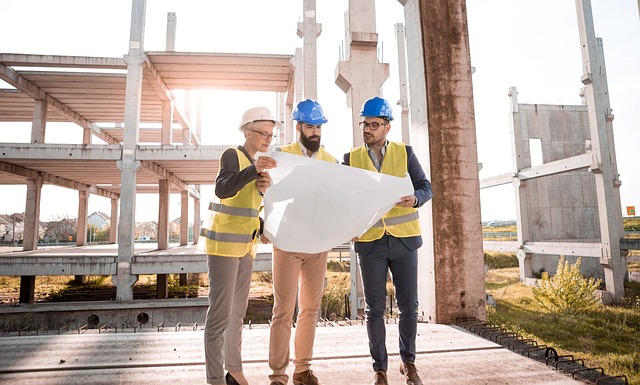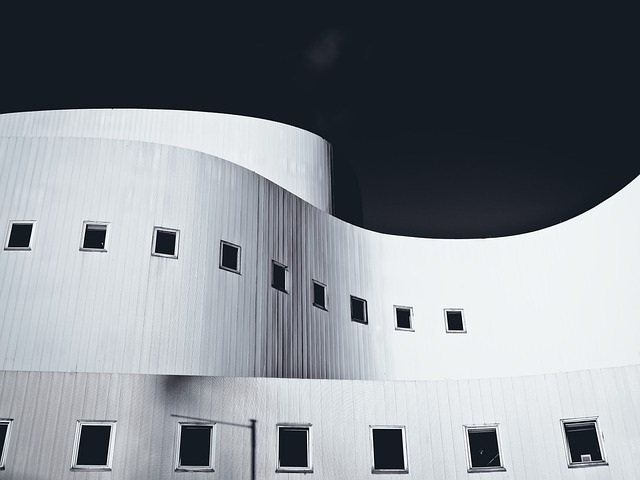When selecting a flashlight for construction workers, especially for nocturnal building inspections, durability, functionality, and a high lumen output are crucial. The ideal flashlight should be built with robust materials like aircraft-grade aluminum to withstand harsh conditions, offer adjustable focus from spotlights to floodlights, include versatile lighting modes (high, medium, low, strobe, SOS), and be water-resistant. A long battery life or rechargeable options are essential for extended use, and features like ergonomic design and red filters for preserving night vision add practical value. Flashlights For Construction Workers must balance brightness with energy efficiency to ensure safety and efficiency during nighttime tasks, making them indispensable tools that enhance the precision and safety of construction workers' operations under the cover of darkness.
When dusk falls on construction sites, clarity is paramount. Ensuring safety and precision during nighttime building inspections hinges on the right illumination. This article sheds light on the critical role of high-quality flashlights for construction workers, emphasizing features that enhance visibility, power efficiency, and durability under demanding conditions. We’ll explore the science behind lumens to guide your selection, the necessity of extended battery life, and the importance of ergonomic designs for comfort during prolonged shifts. For construction workers tasked with after-dark inspections, understanding these aspects is key to selecting flashlights that offer superior performance, ensuring every inspection is conducted with optimal clarity and safety.
- The Necessity of Reliable Flashlights for Construction Workers Conducting Nighttime Inspections
- Key Features to Look for in a High-Quality Flashlight for Building Inspections
- Understanding Lumens and Light Output: How Brightness Matters in Flashlights for Construction Sites
- The Importance of Battery Life and Power Efficiency in Nighttime Inspections
- Durability and Impact Resistance: Ensuring Your Flashlight Stands Up to the Demands of Construction Environments
- Flashlight Modes and Functions: A Guide for Construction Workers Inspecting After Dark
- The Role of Ergonomics in Selecting a Comfortable and Efficient Flashlight for Long Inspection Shifts
The Necessity of Reliable Flashlights for Construction Workers Conducting Nighttime Inspections

Construction workers conducting nighttime inspections must rely on flashlights to navigate and assess building conditions safely and effectively. The reliability of a flashlight during such operations is paramount, as it directly affects both the worker’s safety and the quality of the inspection. Flashlights for construction workers should offer robust illumination with a durable design that withstands the rigors of a construction site. A high-quality beam allows for the detection of cracks, water damage, or structural irregularities that might not be visible under normal lighting conditions. Moreover, the best flashlights in this context feature a long battery life, ensuring they remain operational throughout inspections that could last several hours. Additionally, they should be compact and lightweight to facilitate easy handling without hindering the worker’s dexterity or adding unnecessary weight to their equipment. Features such as adjustable focus and water resistance further enhance their utility, providing construction workers with a dependable tool for nighttime building inspections that contributes to the safety and efficiency of their work.
Key Features to Look for in a High-Quality Flashlight for Building Inspections

When selecting a flashlight for building inspections at night, particularly for construction workers, it’s crucial to prioritize durability and functionality. A high-quality flashlight designed for professional use should feature a robust construction capable of withstanding the rigors of a construction site. Look for flashlights that are built with aircraft-grade aluminum or similar materials, as they offer excellent heat dissipation and resistance to impacts and drops. This ensures that the light remains operational under demanding conditions.
Moreover, brightness and beam intensity are key features for inspecting hard-to-reach areas effectively. A flashlight with a high lumen output will illuminate dark spaces clearly, which is essential for identifying structural issues or safety hazards. Additionally, consider a flashlight that offers multiple lighting modes, including a high, medium, and low setting, as well as a strobe function. This versatility allows users to conserve battery life when necessary and to adjust the intensity of light to suit various environments. A focused beam with a wide flood option is also beneficial, providing both long-distance visibility and close-up illumination as needed. Water resistance is another important feature, ensuring that the flashlight can be used safely even in damp or wet conditions commonly found on construction sites. With these features in mind, construction workers will find a reliable and effective tool to enhance their safety and efficiency during nighttime building inspections.
Understanding Lumens and Light Output: How Brightness Matters in Flashlights for Construction Sites

When selecting a flashlight for construction workers, particularly for nighttime building inspections, it’s crucial to grasp the concept of lumens and how it relates to the light output required for different tasks. Lumens measure the total amount of visible light from a source. In the context of flashlights for construction sites, a higher lumen value indicates a brighter beam, which is essential for inspecting complex structures, identifying potential hazards, or reading intricate blueprints. For instance, a high-lumen flashlight can illuminate hard-to-reach areas with precision, whereas a lower lumen model might suffice for less demanding tasks like moving around a site.
Moreover, the beam type is another important factor. A focused spotlight is ideal for long-range visibility, while a wider floodlight beam is better suited for close-up work where more ambient light is needed. Additionally, considering the runtime and battery life of flashlights is imperative. High-lumen models often consume more power, so construction workers must have flashlights with efficient energy use or equipped with rechargeable batteries to avoid unexpected darkness during critical inspections. Flashlights for construction workers should be durable, lightweight, and provide a balance between brightness and runtime, ensuring that safety and efficiency are not compromised during nighttime operations on a construction site. Understanding the interplay of lumens and beam types will help workers choose the most effective flashlight, enhancing their ability to perform tasks with greater precision and safety in low-light conditions.
The Importance of Battery Life and Power Efficiency in Nighttime Inspections

When conducting building inspections at night, the reliability of a flashlight is paramount, especially for construction workers who rely on clear visibility to identify potential hazards or issues within a structure. Battery life in these flashlights must be robust to endure the duration of an inspection without failure or the need for frequent battery changes. High-quality flashlights designed for construction professionals often feature advanced power management systems that optimize battery usage, ensuring that the light output remains steady and consistent throughout the inspection process. This is crucial as the unpredictability of nighttime environments can lead to situations where more light is needed over extended periods. Moreover, power efficiency in these flashlights does not compromise their brightness or functionality; in fact, it enhances them. Construction workers benefit from a balance between lumens and battery consumption, allowing for the necessary visibility to conduct thorough inspections while maintaining the freedom to operate in various locations within a building without the constraint of a depleting power source. Flashlights for construction workers, therefore, should prioritize long-lasting batteries and energy-efficient designs, making them indispensable tools for nighttime building inspections. Features such as LED technology, adjustable brightness settings, and high-capacity rechargeable batteries are essential for ensuring that these flashlights deliver optimal performance when it’s most needed.
Durability and Impact Resistance: Ensuring Your Flashlight Stands Up to the Demands of Construction Environments

When construction workers navigate building sites at night, the reliability and durability of their equipment are paramount. Flashlights for construction workers must be built to withstand harsh conditions, from accidental drops onto hard surfaces to exposure to dust and debris that characterize active construction sites. A flashlight that can endure such an environment is not a luxury—it’s an essential tool that ensures work continues safely and efficiently. High-impact resistant flashlights, often made with a robust polycarbonate body or reinforced aluminum, are designed to survive the inevitable bumps and falls without compromising their functionality. Furthermore, waterproof and dust-resistant models protect against the elements, maintaining visibility even in the most demanding conditions. The best flashlights for construction workers are equipped with shock-resistant features and a sturdy design that can endure the rigors of daily use, ensuring that the light never fails when needed most. This commitment to durability extends the lifespan of the flashlight, providing a cost-effective solution for construction professionals who require a dependable source of illumination during nighttime inspections and work.
Flashlight Modes and Functions: A Guide for Construction Workers Inspecting After Dark

When construction workers are tasked with conducting inspections at night, the right flashlight becomes an indispensable tool. Flashlights for construction workers are not merely sources of illumination but sophisticated devices equipped with various modes and functions designed to enhance visibility and efficiency in low-light conditions. These modes include high, medium, and low beams, each offering different levels of brightness and battery consumption. High beam, for instance, is ideal for long-range navigation or when working in the most minimal lighting, while medium and low beams are suited for close-up tasks that require finer detail visibility without overwhelming the eyes.
Additionally, modern flashlights for construction workers often come with specialized functions such as strobe, SOS, and red filter options. The strobe function can momentarily stun an individual if necessary, serving as a safety feature in case of emergencies or when navigating potentially hazardous areas. The SOS setting is particularly useful for signaling distress to others. Red filters are beneficial when conserving battery life, as the red light preserves night vision and allows workers to see in the dark without emitting a bright light that could disrupt local wildlife or alert intruders to their presence. These features, combined with durability, water resistance, and ergonomic designs, make flashlights for construction workers a critical component of nighttime inspections, ensuring that work can continue seamlessly under the cover of darkness.
The Role of Ergonomics in Selecting a Comfortable and Efficient Flashlight for Long Inspection Shifts

When construction workers are tasked with conducting building inspections at night, selecting a flashlight that offers both comfort and efficiency is paramount for the task’s successful completion. Ergonomics play a crucial role in choosing the right flashlight; a model that fits securely yet comfortably in the hand, reducing strain and fatigue over extended periods, is essential. Flashlights designed with a focus on ergonomic principles often feature textured grips, an asymmetric body shape, or contoured handles to minimize discomfort during long shifts. These design elements ensure that construction workers can hold the flashlight steady for hours without cramping or fatigue setting in.
Furthermore, the efficiency of a flashlight cannot be overstated. For construction workers engaged in nighttime inspections, a high-quality beam is necessary to clearly illuminate dark spaces and intricate areas where potential issues may lurk. Ergonomic flashlights for construction workers often come with advanced LED technology that provides a bright, focused light, consuming less power than traditional bulbs. This not only prolongs battery life but also reduces the frequency of battery changes or recharging during shifts. Flashlights that offer adjustable brightness settings are particularly advantageous, allowing workers to conserve energy in well-lit areas and boost luminosity as needed in darker spots. The balance between ergonomic design and energy efficiency is critical when selecting a flashlight for construction workers who must perform nighttime building inspections effectively and safely.
When darkness falls on a construction site, the safety and efficacy of building inspections hinge significantly on the flashlights wielded by workers. A high-quality flashlight for construction workers is not just a tool; it’s an integral part of their nighttime inspection kit. It must excel in brightness, powered by reliable battery life, exhibit durability against harsh conditions, and offer versatile modes to adapt to various scenarios. Ergonomics play a crucial role in maintaining worker comfort during extended shifts. In conclusion, selecting the right flashlight for construction workers conducting nighttime inspections is paramount for both safety and productivity. The features outlined in this article serve as a guide to ensure that these indispensable devices meet the demands of the job, ensuring that every corner of a building can be safely illuminated and scrutinized under the cloak of night.
